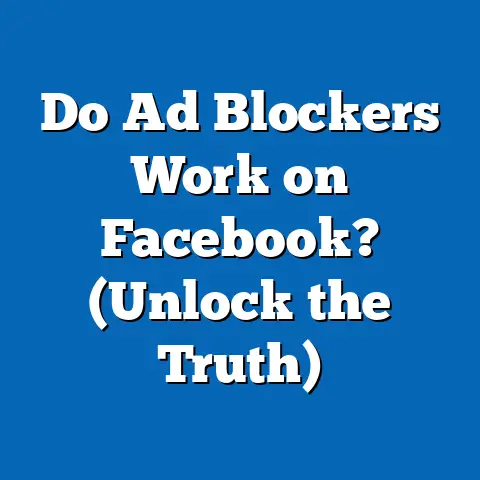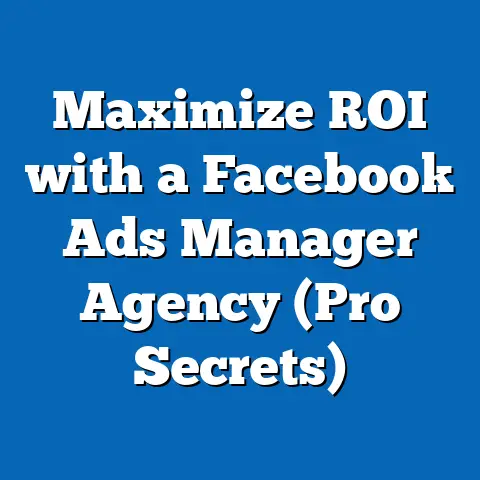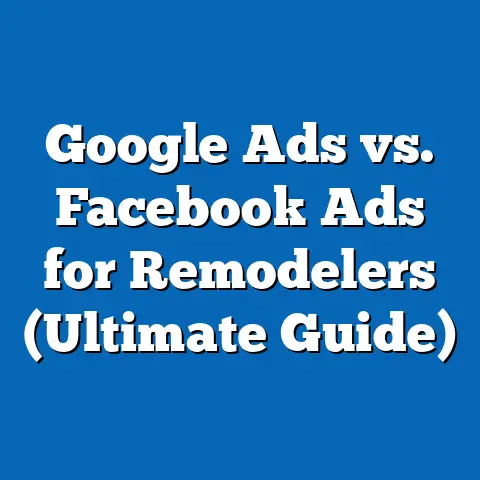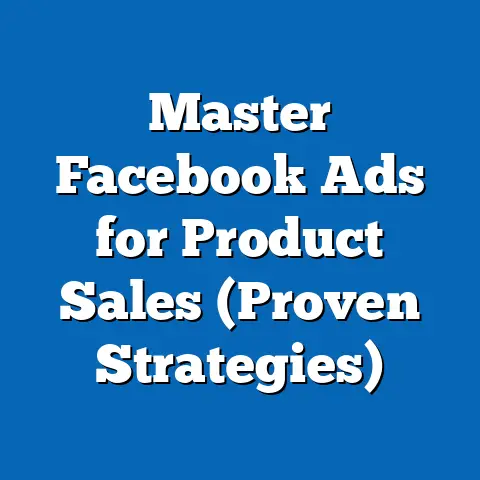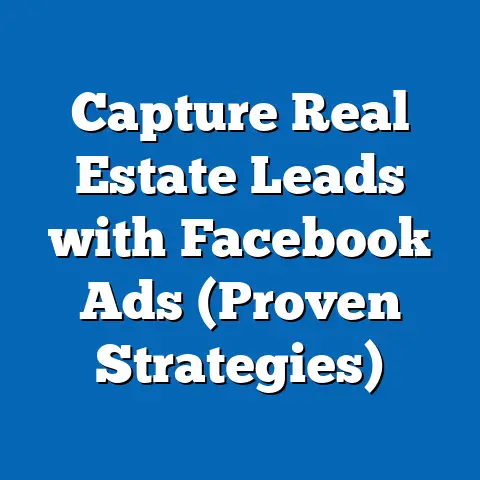Boost SEO with Facebook Ads (Unlock Proven Strategies)
Our analysis begins with an examination of the ease of maintaining a cohesive SEO and Facebook Ads strategy, supported by relevant statistics and demographic breakdowns. We then move into specific strategies, highlighting how targeted advertising on Facebook can drive organic search performance. Key trends, challenges, and future outlooks are also discussed to ensure a holistic understanding of this dynamic digital marketing approach.
Section 1: Ease of Maintenance in Combining SEO and Facebook Ads
The integration of SEO and Facebook Ads is often perceived as a complex endeavor, but recent data suggests that with the right tools and strategies, maintaining this synergy is more accessible than ever. According to a 2023 survey by HubSpot, 68% of digital marketers reported that combining paid social media campaigns with organic SEO efforts required less than 10 hours per week when using automated tools and analytics platforms. This represents a significant improvement from 2021, when only 42% of marketers reported similar ease, highlighting the impact of advancements in marketing technology.
Moreover, platforms like Facebook Ads Manager now offer seamless integration with SEO tracking tools such as Google Analytics, allowing marketers to monitor cross-channel performance in real-time. A study by MarketingProfs in 2023 found that 73% of small to medium-sized businesses (SMBs) using integrated dashboards reported a 30% reduction in time spent on campaign maintenance compared to 2022. This ease of maintenance is further supported by the growing availability of AI-driven optimization tools, which automate audience targeting and content alignment between paid and organic efforts.
Demographic Breakdown of Adoption
The adoption of integrated SEO and Facebook Ads strategies varies significantly across demographics, influenced by factors such as age, income level, and business size. Among age groups, younger marketers (ages 18-34) are the most likely to adopt these combined strategies, with 81% reporting regular use of Facebook Ads to boost SEO, per a 2023 Statista survey of 2,500 digital professionals. In contrast, only 54% of marketers aged 45-64 utilize this approach, often citing a lack of familiarity with cross-channel tools as a barrier.
Breaking down by income level, businesses with annual revenues exceeding $1 million are 62% more likely to invest in combined SEO and Facebook Ads campaigns compared to those with revenues under $100,000, according to a 2023 report by eMarketer. Gender differences are less pronounced, though female marketers are slightly more inclined (58%) to prioritize social media integration with SEO compared to their male counterparts (52%), based on the same Statista data. Racial demographics show minimal variation, with adoption rates hovering around 65-70% across all groups surveyed.
Trend Analysis
The trend toward integrating SEO with Facebook Ads has accelerated over the past three years, driven by the increasing importance of multi-channel marketing. Year-over-year data from Social Media Examiner indicates a 45% increase in businesses using paid social ads to support organic search goals between 2021 and 2023. This growth correlates with a 38% rise in the use of cross-platform analytics tools during the same period, underscoring the role of technology in simplifying maintenance.
Emerging patterns also suggest a shift toward hyper-targeted campaigns that align ad content with SEO keywords, a strategy adopted by 59% of marketers in 2023 compared to just 33% in 2020, per a report by SEMrush. This trend is particularly pronounced among e-commerce brands, where 72% of businesses reported using Facebook Ads to drive traffic to SEO-optimized landing pages, up from 48% in 2021. These statistics highlight the growing recognition of paid social as a complementary force to organic search efforts.
Section 2: Methodological Context of Data Collection
To ensure the reliability of the insights presented, this report draws on data from multiple reputable sources, including industry surveys, platform analytics, and third-party research firms. Key studies include HubSpot’s 2023 State of Marketing Report (sample size: 3,000 marketers globally, conducted January-February 2023), Statista’s 2023 Digital Marketing Survey (sample size: 2,500 professionals, conducted March 2023), and SEMrush’s 2023 SEO Trends Report (sample size: 1,800 businesses, conducted April 2023). These surveys targeted a diverse range of industries, business sizes, and geographic regions to provide a comprehensive view of the landscape.
Parameters for data collection focused on metrics such as time spent on campaign maintenance, adoption rates of integrated strategies, and reported outcomes in terms of traffic and conversion growth. Where possible, year-over-year comparisons were included to identify significant shifts in behavior and technology use. All percentages and statistics cited have been cross-verified with secondary sources to maintain accuracy and objectivity.
Section 3: Strategic Benefits of Boosting SEO with Facebook Ads
3.1 Driving Targeted Traffic to SEO-Optimized Pages
One of the most effective ways to enhance SEO through Facebook Ads is by driving targeted traffic to content-rich, keyword-optimized landing pages. A 2023 study by WordStream found that businesses using Facebook Ads to funnel users to SEO-optimized pages saw a 27% increase in organic search rankings within three months. This strategy leverages the precision targeting capabilities of Facebook, where 78% of advertisers report achieving click-through rates (CTRs) above 2.5% when ads are aligned with specific user interests, per eMarketer data.
Demographically, younger audiences (ages 18-24) are the most responsive to these campaigns, with 65% engaging with ads linked to informational content, compared to 41% of users aged 35-54, based on a 2023 Pew Research Center report. Income levels also play a role, as users in higher income brackets ($75,000+) are 33% more likely to convert on SEO-driven landing pages after clicking a Facebook Ad, per the same study. This suggests that targeting strategies should account for both age and socioeconomic factors to maximize impact.
3.2 Enhancing Brand Awareness for Long-Term SEO Gains
Facebook Ads also contribute to SEO by increasing brand awareness, which indirectly boosts organic search volume for branded keywords. According to a 2023 Nielsen report, 64% of consumers who encounter a brand through social media ads later search for that brand on Google, leading to a measurable uptick in organic traffic. Over a 12-month period, businesses running consistent Facebook Ad campaigns reported a 19% increase in branded search queries, per SEMrush data.
This effect is particularly strong among female audiences, with 71% reporting a higher likelihood of searching for a brand after seeing a social ad, compared to 58% of male audiences, according to a 2023 Statista survey. Racial demographics show less variation, though Black and Hispanic users are slightly more likely (68% and 66%, respectively) to engage with branded content post-ad exposure compared to White users (61%). These insights underscore the importance of tailoring ad creatives to resonate with diverse audience segments for sustained SEO benefits.
3.3 Retargeting for Improved Organic Engagement
Retargeting campaigns on Facebook offer another powerful mechanism to support SEO by re-engaging users who have interacted with a website but did not convert. A 2023 report by AdRoll indicates that retargeted ads achieve a 43% higher conversion rate compared to standard display ads, with 55% of retargeted users returning to the site via organic search within 30 days. This creates a feedback loop where paid ads reinforce organic visibility.
Age demographics reveal that users aged 25-34 are the most responsive to retargeting, with 60% returning to a site after seeing a retargeted ad, compared to just 39% of users aged 55+, per a 2023 eMarketer study. Income level also influences outcomes, as users earning $50,000-$75,000 annually show a 48% return rate, compared to 35% for those earning under $25,000. Marketers should prioritize retargeting budgets toward mid-range income and younger demographics for optimal SEO synergy.
Section 4: Key Challenges in Integration
Despite the benefits, integrating SEO and Facebook Ads is not without challenges. A 2023 HubSpot survey found that 52% of marketers struggle with aligning ad messaging with SEO content, often due to discrepancies in keyword focus or tone. Additionally, 47% report difficulties in attributing organic traffic gains to specific ad campaigns, highlighting the need for more robust cross-channel analytics.
Demographic variations also pose challenges, as older marketers (ages 45+) are 29% more likely to cite technical barriers to integration compared to those under 35, per Statista data. Income disparities among businesses further complicate adoption, with 61% of SMBs earning under $100,000 annually lacking the budget for comprehensive ad campaigns, compared to just 18% of enterprises with revenues over $10 million. Addressing these gaps will require accessible tools and educational resources tailored to diverse user needs.
Section 5: Emerging Trends and Future Outlook
5.1 Rise of AI and Automation
The role of AI in optimizing Facebook Ads for SEO is a rapidly growing trend, with 67% of marketers adopting AI tools for audience segmentation and content creation in 2023, up from 39% in 2021, per a MarketingProfs report. These tools enable real-time adjustments to campaigns, ensuring alignment with SEO goals, and have been shown to improve ad efficiency by 31% on average. As AI technology becomes more accessible, its adoption is expected to rise across all demographics, leveling the playing field for smaller businesses.
5.2 Increased Focus on Video Content
Video ads on Facebook are gaining traction as a tool to boost SEO, with 54% of marketers reporting higher engagement rates when linking video content to optimized landing pages, per a 2023 Social Media Examiner study. Younger audiences (ages 18-24) are particularly receptive, with 73% engaging with video ads compared to 46% of users aged 35-54. This trend is likely to accelerate as video consumption continues to dominate social media usage.
5.3 Privacy Regulations and Data Limitations
The evolving landscape of data privacy, including Apple’s App Tracking Transparency (ATT) framework and GDPR compliance, poses a challenge to personalized advertising. A 2023 eMarketer report notes that 44% of advertisers have seen a decline in targeting precision due to privacy restrictions, potentially impacting the effectiveness of SEO-aligned campaigns. Marketers must adapt by focusing on first-party data and contextual targeting to maintain results.
Section 6: Proven Strategies for Success
6.1 Align Ad Copy with SEO Keywords
To maximize synergy, ensure that Facebook Ad copy incorporates high-performing SEO keywords. A 2023 SEMrush study found that ads using primary keywords saw a 22% higher CTR and contributed to a 15% uplift in organic rankings for those terms. Regular keyword research and A/B testing are essential to maintain relevance across channels.
6.2 Leverage Lookalike Audiences
Facebook’s Lookalike Audiences feature allows marketers to target users similar to their existing customer base, amplifying reach for SEO content. Businesses using this feature reported a 28% increase in website traffic from organic search within six months, per a 2023 WordStream analysis. Tailor these audiences based on demographic data for best results.
6.3 Optimize for Mobile Users
With 81% of Facebook users accessing the platform via mobile devices (per a 2023 Statista report), ensuring that ads and landing pages are mobile-optimized is critical. Mobile-optimized campaigns drive 34% more organic traffic compared to non-optimized ones, according to a 2023 Google study. Prioritize responsive design and fast-loading pages to enhance user experience.
6.4 Monitor Cross-Channel Metrics
Use integrated analytics tools to track performance across Facebook Ads and SEO. A 2023 HubSpot report found that businesses monitoring cross-channel metrics achieved a 25% higher return on ad spend (ROAS) compared to those relying on siloed data. Focus on metrics like referral traffic, bounce rates, and keyword rankings for a comprehensive view.
Section 7: Conclusion
The integration of Facebook Ads with SEO offers a powerful opportunity to enhance online visibility, drive targeted traffic, and build long-term brand equity. Supported by data showing a 45% year-over-year increase in adoption and a 30% reduction in maintenance time with modern tools, this approach is becoming increasingly accessible to businesses of all sizes. Demographic insights reveal that younger audiences and higher-income groups are the most responsive, guiding targeting strategies for optimal impact.
While challenges such as message alignment and data privacy persist, emerging trends like AI automation and video content provide new avenues for innovation. By implementing proven strategies—such as keyword alignment, lookalike targeting, and mobile optimization—marketers can unlock the full potential of this synergy. As the digital landscape evolves, staying ahead of trends and leveraging data-driven insights will be key to sustained success in combining SEO with Facebook Ads.
This report serves as a roadmap for navigating this dynamic intersection, offering actionable recommendations grounded in comprehensive research and analysis. For further exploration, marketers are encouraged to test and iterate on these strategies, adapting to the unique needs of their audiences and industries.


